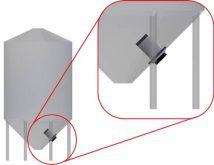Warm weather during the 2012 grain harvest benefited producers, but it also benefited insects that feed in stored grain, says Brent Elliott, infestation control and sanitation officer at the Canadian Grain Commission. However, cold winter weather can help producers control insects.
“Now that winter’s here, producers need to reconsider how they’re managing insects in their stored grain,” explained Mr. Elliott. “Because fumigation does not work below 5 C, it’s not the preferred method for insect control. The good news is cold temperatures are very helpful for controlling insect populations.”
Read Also

New rules for organic farming on the table
Canada’s organic farmers have until July 29 to comment on new standards that would allow permit more products, but also crack down on organic management lapses.
Colder temperatures allow producers to control insects by using a combination of aeration and grain movement.
Using aeration
Aeration systems preserve stored grain and keep it dry by reducing the temperature of grain and reducing moisture migration. If you use an aeration system for your bins, you should turn it on during the winter months to cool your grain. The temperature of the grain and the ambient temperature outside will dictate how long to leave aeration on. More information about aeration is available on the Canadian Grain Commission’s website, www.grainscanada.gc.ca.
Prairie winters are usually quite cold, making winter the ideal time for cooling grain. At -20 C, it only takes one week to disinfest or control all life stages of stored insect pests. The time needed for disinfestation changes depending on the grain’s temperature as shown in the table.
Using grain movement
You can also use grain movement, which can kill insect pests such as the rusty grain beetle and red flour beetle.
Augering grain out of a bin and then back in will reduce the insect population. Augering also helps to break up any hot spots in the grain. Moulds and secondary insect pests, such as the foreign grain beetle, can develop in hot spots.
In cold weather, grain exposed to cold air during augering will cool off quickly. This may help to reduce your aeration time. However, you should always monitor the temperature of the grain in storage to be sure.

















